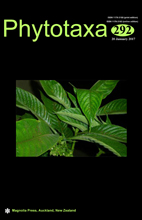Abstract
A new species of Ranunculaceae, Semiaquilegia guangxiensis, is described and illustrated. The plant is morphologically similar to S. adoxoides, but it obviously differs from the latter by the following characteristics: stamens 20–30 (vs. 8–14 in S. adoxoides); staminodes ca. 10, half the length of the filaments (vs. ca. 2, as long as filaments in S. adoxoides); follicles ca. 1 cm long, ca. 3 mm wide (vs. 6–7 mm long, ca. 2 mm wide in S. adoxoides); seeds 1.5–2.5 mm long (vs. ca. 1 mm long in S. adoxoides). Its affinity to S. adoxoides and placement in Semiaquilegia are confirmed by phylogenetic analyses based on nuclear ITS and chloroplast trnL-F sequences.

